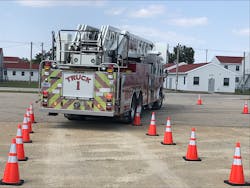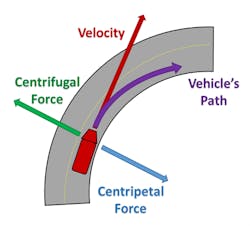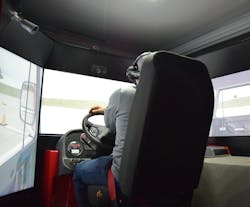Heavy Vehicles Equal Heavy Responsibility
Consider this: You are a new officer training a junior firefighter to drive a six-month-old, $500,000 engine for the first time. The firefighter climbs into the driver’s seat and says, “I never drove anything bigger than my compact car.”
Truth be told, you are a little nervous when you contemplate the responsibility and the potential consequences of a driver training session gone wrong: damaging the new engine, damaging civilian property or, worst of all, injuring someone.
Unfortunately, this scenario occurs regularly, because it’s the only readily accessible method for departments for fire apparatus driver training. Eventually, all firefighters must log their first miles driving the “big red truck” down the road. However, we can better prepare these members for this moment.
There is a stark difference between the vehicle dynamics and handling of fire apparatus compared with personal vehicles and light emergency vehicles, such as ambulances. A solid understanding of the various elements that act on a vehicle in motion, including interacting forces, center of gravity, and liquid slosh and surge, are required to adapt to these differences.
Interacting forces
Four primary forces work together to control the path of a vehicle that’s in motion.
Momentum is the product of a vehicle’s mass times its velocity. A 40,000-lb. engine has a greater mass than a 10,000-lb. ambulance; therefore, the engine has greater momentum and will take a greater distance to stop than an ambulance that travels at the same speed.
Inertia is the resistance to change of a vehicle’s velocity. Once a vehicle is in motion, inertia causes the vehicle to move in a straight line, resisting any change in the direction of the vehicle. Inertia increases as momentum increases.
Centripetal force, the so-called “center-seeking” force, acts on the vehicle laterally in the direction of the center of the turn. This force is applied by the driver’s control of the steering wheel, which turns the wheels, causing the tires to pull the vehicle from a straight path.
Centrifugal force, the so-called “center-fleeing” force, acts on the vehicle and its contents by pushing outward laterally in the direction opposite of the turn. You experience this force when you turn a corner, feeling the vehicle lean and your body move away from the center.
Inertia, centripetal force and centrifugal force affect vehicle control and interact to keep the vehicle within its lane while going around a curve or corner. Centripetal force must be applied by steering the vehicle to change its path. The inertia of the vehicle tries to maintain a straight velocity, which produces centrifugal force. A sufficient amount of centripetal force must be applied to counteract centrifugal force to cause the vehicle to turn.
Center of gravity
Because of their increased height and weight, fire apparatus handle vastly differently than lighter vehicles. Most apparatus are 10–12 feet tall and approximately 15 times the weight of a passenger vehicle and 3–4 times the weight of an ambulance. The increased height and weight of apparatus raise their center of gravity, which allows centrifugal force to have a more significant effect. This results in more dramatic weight shifts and body roll than typically is experienced in smaller vehicles. Aggressive driver speed, steering and braking actions result in more severe weight shifts than with smaller vehicles. The force of these weight shifts can cause a vehicle skid by exceeding the amount of traction that’s between the tire and the ground. The force also can cause a rollover because of the center of gravity moving beyond the tipping point.Liquid slosh and liquid surge
Most fire apparatus carry liquid extinguishing agents. Liquids are a live load, meaning that they will move as the vehicle moves. This movement is called liquid slosh and liquid surge. The effects of liquid slosh and liquid surge increase as the amount of liquid that’s carried on a vehicle increases.
Liquid slosh is the movement of liquids from side to side in the vehicle. This movement can cause a vehicle to roll over.
Liquid surge is the movement of liquids fore and aft, typically the result of braking or acceleration. This movement tends to push the vehicle forward when braking. On wet or slick roads, the momentum from a liquid surge when braking can cause the vehicle to skid into an intersection.
When turning, the combination of centrifugal force, high center of gravity, and the forward and lateral momentum of liquid slosh and liquid surge can cause fire apparatus to roll over. Tender apparatus particularly are susceptible to this.
Most fire apparatus water tanks are baffled to reduce the effects of liquid slosh and liquid surge; however, they don’t eliminate them. Drivers can minimize liquid slosh and liquid surge by avoiding both abrupt steering while braking and aggressive acceleration, braking and steering. To further prevent these effects, fire apparatus only should be driven with completely full or completely empty water tanks.
Hands-on training
Although it’s important for new drivers to have a cognitive understanding of the forces that act on a vehicle, they also must feel these forces in the driver’s seat to completely understand vehicle dynamics. Before driving on public streets, new drivers often complete a precision “cone driving course” to comprehend the physical size of fire apparatus and practice essential driving tasks, such as mirror usage. Although beneficial, the cone driving course focuses on maneuvering in tight spaces and, therefore, normally is completed at very low speeds. This prevents new drivers from feeling the vehicle dynamics that are discussed above. It’s imperative that new drivers experience these vehicle dynamics before they find themselves in an emergency situation without familiarity of the vehicle’s reactions.
The application of some simple exercises enables new drivers to experience vehicle dynamics. A large, open area that’s suitable for new drivers to safely operate the vehicle at moderate speeds (approximately 10–20 mph) should be utilized. (Since the repetition of these exercises might damage pavement, an appropriate area must be used. Safe operation of the vehicle must be ensured at all times.)
The first exercise is a modified serpentine course in the forward direction only. Traffic cones should be spaced sufficiently for the given speed and vehicle type. The driver approaches at the given speed and weaves through the cones, maintaining speed to induce the aforementioned forces and the resulting vehicle weight shifts.
In the second exercise, the driver makes a turn at an appropriate speed and brakes aggressively during the turn to exacerbate the shift in weight and to induce liquid slosh and liquid surge.
For the third exercise, the driver disengages the engine brake and reaches a designated speed then brakes hard in a straight line to experience the forward vehicle weight shift and liquid surge that occurs during emergency braking. This exercise should be repeated with the engine brake engaged at low, medium and high to experience its effect.
These exercises should be repeated several times, starting with a slower speed then gradually increasing, maintaining the safe operational limits of the vehicle.IFSI simulation
The Illinois Fire Service Institute (IFSI) recognized the need for its students to develop these essential skills with hands-on training, so it created its Driver Readiness Interactive Vehicle Experience (DRIVE) program. The program facilitates the safe training of emergency vehicle drivers via the highest level of realism possible. All of the state-of-the-art, high-fidelity driving simulators are equipped with motion actuators.
The program allows thousands of students to experience the vehicle dynamics and weight shifts that are characteristic of fire apparatus. It also incorporates several defensive driving exercises that are similar to those that are described above. This permits students to explore the safe operational limits of an emergency vehicle and to exceed them in a safe environment.
IFSI operates two mobile simulation laboratories that deliver this crucial training to fire departments across Illinois at no cost through the Cornerstone program.
About the Author
Tal Prendergast
Tal Prendergast serves as a lieutenant with the Urbana, IL, Fire Department. He is a field staff instructor and the driver/operator program director for the Illinois Fire Service Institute, which delivers nationally accredited, hands-on driver/operator training across the United States.
Jake Hutchcraft
Jake Hutchcraft serves as an engineer with the Urbana, IL, Fire Department. He is a field staff instructor and the apparatus driver program manager for the Illinois Fire Service Institute.


